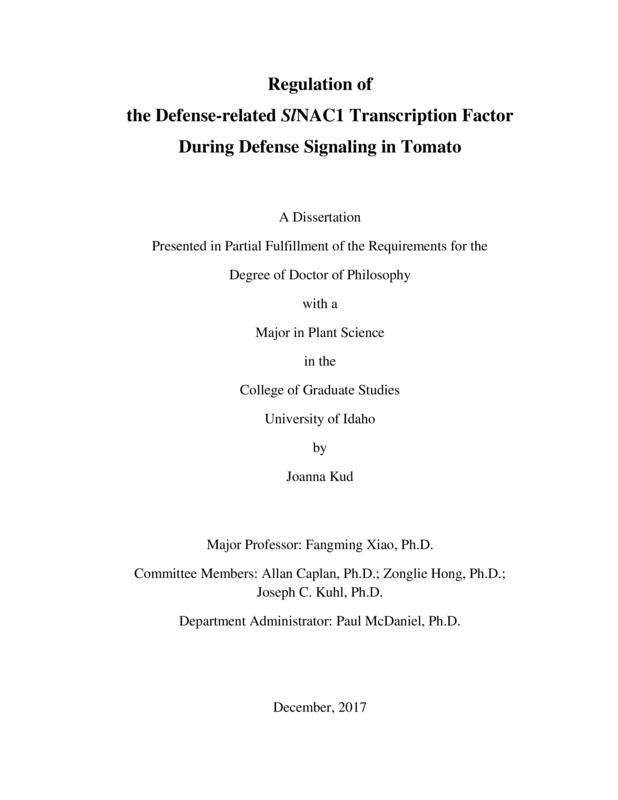Regulation of the Defense-related SlNAC1 Transcription Factor During Defense Signaling in Tomato
Kud, Joanna Helena. (2017-12). Regulation of the Defense-related SlNAC1 Transcription Factor During Defense Signaling in Tomato. Theses and Dissertations Collection, University of Idaho Library Digital Collections. https://www.lib.uidaho.edu/digital/etd/items/kud_idaho_0089e_11238.html
- Title:
- Regulation of the Defense-related SlNAC1 Transcription Factor During Defense Signaling in Tomato
- Author:
- Kud, Joanna Helena
- Date:
- 2017-12
- Embargo Remove Date:
- 2020-09-05
- Keywords:
- defense signaling E3 ligase NAC Prf SINA 3 transcription factor
- Program:
- Plant, Soil and Entomological Sciences
- Subject Category:
- Plant sciences; Molecular biology; Genetics
- Abstract:
-
As sessile organisms, plants are constantly exposed to diverse pathogens. Mounting a successful defense response depends on the early recognition of a pathogen’s presence, followed by a rapidly transmitted signal that is decoded and translated into appropriate cellular events by transcription factors (TFs). Thus, plants have evolved a sophisticated and deeply interconnected signaling network with defense-related TFs tuning plant immunity in a precise spatial-temporal manner.
The main goal of my doctoral research is to study the molecular basis of defense signaling in tomato in response to Pseudomonas syringae pv. tomato (Pst) infection, with particular focus on the defense-related SlNAC1 TF. In tomato, resistance to Pst is achieved by two proteins, the Pto Ser/Thr kinase and the Prf resistance protein, which work together to initiate Hypersensitive Response (HR) cell death upon detection of Pst-secreted effectors, AvrPtoB and AvrPto. Although the role of Pto and Prf in tomato immunity to Pst were described almost two decades ago, direct downstream signaling components that translate pathogen detection into an appropriate cellular defense events remain elusive.
It was previously reported that NAC1-silenced Nicotiana benthamiana plants show compromised immunity to Pst. The steady-state level of SlNAC1 is controlled by the ubiquitin-proteasome system. Here, the tomato SlSINA3 was identified as a cognate E3 ubiquitin ligase specifically binding to and ubiquitinating SlNAC1 to promote its degradation in the absence of Pst. Upon AvrPtoB/AvrPto detection by the Pto kinase, the Prf resistance protein is activated to interact with and stabilize SlNAC1 to stimulate its transcriptional activity. The presented data suggest a model that Prf interferes with SlNAC1 ubiquitination by sequestering SlNAC1 away from SlSINA3 to prevent its degradation, thereby, enabling robust transcriptional reprograming. Significantly, SlNAC1 is a positive regulator of HR cell death and its overexpression in transgenic tomato is associated with the elevated level of SA, and reduced expression of JA, -marker genes.
Together, my dissertation studies uncover the dynamic post-transcriptional regulation of SlNAC1, in which the interplay between SlSINA3 and activated Prf allows for a delicate balance between preventing costly autoimmunity in the absence of the pathogen and rapidly activating defenses once the pathogen is detected.
- Description:
- doctoral, Ph.D., Plant, Soil and Entomological Sciences -- University of Idaho - College of Graduate Studies, 2017-12
- Major Professor:
- Xiao, Fangming
- Committee:
- Caplan, Allan; Hong, Zonglie; Kuhl, Joseph
- Defense Date:
- 2017-12
- Identifier:
- Kud_idaho_0089E_11238
- Type:
- Text
- Format Original:
- Format:
- application/pdf
- Rights:
- In Copyright - Educational Use Permitted. For more information, please contact University of Idaho Library Special Collections and Archives Department at libspec@uidaho.edu.
- Standardized Rights:
- http://rightsstatements.org/vocab/InC-EDU/1.0/

